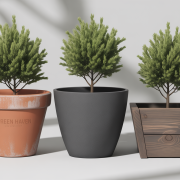Most gardeners know the basics of gardening. But even if you have been gardening for years, you might make some mistakes without realizing it. These can cost you both time and money. Nothing’s more painful than watching your plants wilt and die because of your doing.
This article will list down nine of the most common gardening mistakes and how to avoid them.
1. Under and Overwatering Your Plants
One of the gardeners’ most common gardening mistakes is under or overwatering their plants. While finding the perfect balance of watering can be tricky, it is essential to remember that too much water can suffocate plants and cause root rot. Meanwhile, too little water will lead to wilting.
It is crucial to determine your soil type to ensure that your plants get the perfect amount of water. Different soils will hold water differently and require different amounts. Once you figure out your soil type, you can use a moisture meter or a simple finger test to determine if your plants need more or less water to thrive.
2. Not Using Mulch
Another common error that a lot of people make is not using mulch. Mulching your plants and soil can provide numerous benefits, including protection for the roots of your plants from extreme temperatures and retaining moisture in the ground.
When applying mulch, use an appropriate type for your specific plants. Organic mulches such as bark, grass clippings, and compost are best for most gardeners. Meanwhile, inorganic mulches such as gravel and plastic should be reserved for specific situations.
3. Planting the Wrong Plants in the Wrong Place
Planting the wrong plants in the wrong place is also another error many gardeners make. Not all plants are suited to every environment, and it is vital to research what will work best for your specific situation. Additionally, select appropriate plants for your garden size and have enough space between them to grow without overcrowding.
4. Overcrowding Your Plants
Overcrowding plants is never good. Not only does this lead to competition for resources such as water and light, but it can also create an environment ripe for disease and pests. When planting, leave enough space between your plants, so they can thrive without competing with one another.
5. Not Rotating Your Crops
Crop rotation is an integral part of gardening, and many gardeners neglect to do it. Rotating your crops helps to ensure that nutrients are not depleted from the soil and prevents diseases from becoming too prevalent in one area. Research what crops you should plant after each season to ensure that your soil remains balanced and healthy.
6. Not Pruning Your Plants
Pruning is an essential part of gardening and should not be neglected. Pruning helps to ensure that your plants are growing as they should and encourages healthy new growth. When pruning, use clean tools and cut at the appropriate angle to avoid damaging the plant.
7. Not Preparing the Soil
It is essential to properly prepare your soil before planting, as this can determine the success of your crop. Use a rototiller or spade to loosen up the dirt and mix in compost or organic material to provide nutrients to your plants. Additionally, you should test the pH of your soil to ensure it is at a level where plants can thrive.
8. Fertilizing Too Much or Too Little
Fertilizing is an essential part of gardening. However, it can be easy to over or under-fertilize. When applying fertilizer, read the packaging carefully and follow the instructions on how much should be used. Applying too much or too little fertilizer can burn your plants’ leaves and stunt their growth.
9. Not Removing Dead Plants and Weeds
It is important to regularly remove dead plants and weeds from your garden, as they can quickly take over. Dead plants and weeds can inhibit the growth of healthy plants, deplete soil nutrients and introduce disease or pests. Pull these out as soon as you see them to keep your garden thriving.
These are only a few of the most common mistakes that gardeners make. With just a little research and preparation, you will be well on your way to having a beautiful, healthy garden.
Grow a Lush and Healthy Garden
Gardening is a rewarding activity, but it can also be full of mistakes if you don’t take the appropriate steps to ensure success.
Do your research before planting. Prepare the soil properly and prune your plants correctly. Also, fertilize with the proper doses, rotate your crops, and remove dead plants and weeds to ensure that your plants grow optimally. With patience and a little preparation, you can have a beautiful garden that will thrive.













[…] keep your garden soil healthy and productive, fertilizing is essential. Different plants require different nutrient needs, so […]